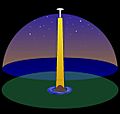Creation myth facts for kids

A creation myth is a special story that explains how the world began and how people first came to live in it. Even though the word "myth" sometimes means a made-up story, in this case, it doesn't mean it's false. People who tell these myths usually believe they are true and hold deep meaning.
These stories are seen as carrying important truths, often using symbols or metaphors. Many creation myths are also "cosmogonic" myths. This means they describe how the universe became organized from a state of total disorder or nothingness.
Creation myths share common features. They are often seen as sacred stories and are found in almost every religion around the world. They all have a plot and characters, which can be gods, human-like figures, or animals. These characters often speak and can change forms easily.
These myths answer big questions that are important to the people who tell them. They help explain a culture's main way of looking at the world and how individuals fit into the universe. Since creation myths are often passed down by word of mouth, there can be many different versions of the same story. They are found in cultures all over the world and are one of the most common types of myths.
Contents
What Are Creation Myths?
Modern experts describe creation myths in a few ways:
- They are "symbolic stories about how the world started, as understood by a certain group of people. Creation myths are super important for how people value the world, how they find their place in the universe, and for the basic ways of life in a culture."
- They "tell us how things began. All cultures have creation myths; they are our most basic stories."
- They are a deeper look into the first story of creation within a religious community. The term "creation" here means the very beginning of things, whether it's by a powerful being, a main source, or in any other way.
Common Themes in Creation Stories
Many creation myths share similar ideas, even if they come from different parts of the world.
From Nothingness or Chaos
A common theme is the idea that the world began from nothing, or from a state of complete disorder and emptiness, called chaos. Over time, this chaos becomes organized into the world we know.
Powerful Beings or Gods
Often, a powerful god or a group of gods is responsible for creating the world. These gods might speak the world into existence, shape it from raw materials, or even sacrifice themselves to form parts of the universe.
World Egg or Cosmic Tree
Some myths describe the world hatching from a giant egg, like a "cosmic egg." Others talk about a huge tree that connects different parts of the universe, like the sky, earth, and underworld.
First Humans and Animals
Creation myths also explain how the first humans and animals came to be. Sometimes, they are formed from clay, wood, or other natural materials. Other times, they emerge from the earth or are given life by the gods.
Order and Rules
After creation, many myths describe how the world got its rules and how things like day and night, seasons, and natural laws came into being. They often explain why things are the way they are in the world.
Images for kids
-
Structure of the world, according to Finnish mythology.
-
In Daoist creation myth, "The Way gave birth to unity; unity gave birth to duality; duality gave birth to trinity; trinity gave birth to the myriad creatures." (Daodejing, 4th century BCE)
-
Creation on the exterior shutters of Hieronymus Bosch's triptych The Garden of Earthly Delights (c. 1490–1510)
-
In the kiva of both ancient and present-day Pueblo peoples, the sipapu is a small round hole in the floor that represents the portal through which the ancestors first emerged. (The larger hole is a fire pit, here in a ruin from the Mesa Verde National Park.)
See also
 In Spanish: Mito de la creación para niños
In Spanish: Mito de la creación para niños







